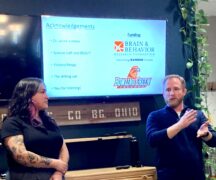By DAVID DUPONT
BG Independent News
Julius Caesar in his namesake play by Shakespeare got it wrong.
”But I am constant as the Northern Star, of whose true fixed and resting quality there is no fellow in the firmament,” the soon to be late Caesar declares.
Turns out, Polaris is not constant, it is a variable star, specifically a cepheid variable star, explained Andrew Layden, chair of the BGSU Department of Physics & Astronomy, during the June Science Café.
The theme of the talk, held in Juniper Brewing in downtown BG, was variable stars. These are stars which seem to blink or more slowly vary in brightness. They represent less than one percent of the stars, Layden said, but they are still important in to understanding the cosmos.
They come in two basic forms.
Eclipsing binary star systems have two stars that rotate around each other, periodically blocking its celestial mate. The extent of the eclipse depends on a number of factors — how bright they are, their mass, and radius relative to each other.
Their variability, he said, is extrinsic. It has to do not with any inherent quality of the star, but how they are perceive from another angle in the universe, they may not be variable at all.
The second type, the cepheid variable star, changes because of intrinsic qualities of the star. As it burns its fuel it can seem brighter, but then as the fuel is expended it collapses, and that process allows it to recharge and repeat the process.
These qualities in both the type of stars have allowed scientists to draw important lessons about the universe.
“Cepheid variables have played a major part in determining distances to far-away galaxies and determining the age of the universe,” Layden said.
Using observations from cepheid variables has enabled scientists to create a 3D map of the universe.
Eclipsing binaries have help determine the radius and mass of other stars.
The North Star’s changes in brightness are hard to detect with the naked eye, Layden said. But astronomers have determined its cycle last just under 4 days, but that has slowly been shortening. But as its cycle has been shortening, it has been getting brighter at its more intense.
“We have a piece of evidence that stars evolve over time,” Layden said.
Making these observations are not easy. It requires someone spending the night at an observatory, looking through a telescope. That job is usually relegated to graduate students.
Now many of those observations are made by remote, robotic telescopes that take a steady stream of images that astronomers can view and download online.
Two BGSU graduate students were on hand a the science café. Julia Evangelista discovered the beauty of the night skies looking through her uncle’s telescope in northern Michigan.
Tiyinoluwa Olushola-Alao grew up in Lagos, Nigeria. It was only when he traveled to his father’s home village in a remote section of northern Nigeria that he discovered the beauty of the night sky.
“The majesty of the stars gave me the impression it would be very cool to be an astronaut,” he said. But he discovered that being an astronaut was “not height appropriate” for him. So he studied astronomy.
During the question and answer session, one attendee asked why was this worth the effort and money?
Olushola-Alao said he was attracted to science because of its ability to answer questions. But it goes deeper than that.
“There’s something inherently successful about the human experience when we invest our time and resources into learning more,” he said. “The purpose for science to solve specific problems came as a result of people doing science to discover things.”
Modern science is built on Isaac Newton’s discoveries about gravity and math. The 17th century English polymath did this because he enjoyed the process. “The things he discovered for fun have become a cornerstone of our scientific understanding,” Olushola-Alao said.
“The point of science is doing science,” though he conceded that may be hard to get funding for this. Still “inherent to studying science is the process. There’s something inherently human in that. Science is an end in itself more than a means.”





